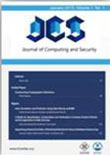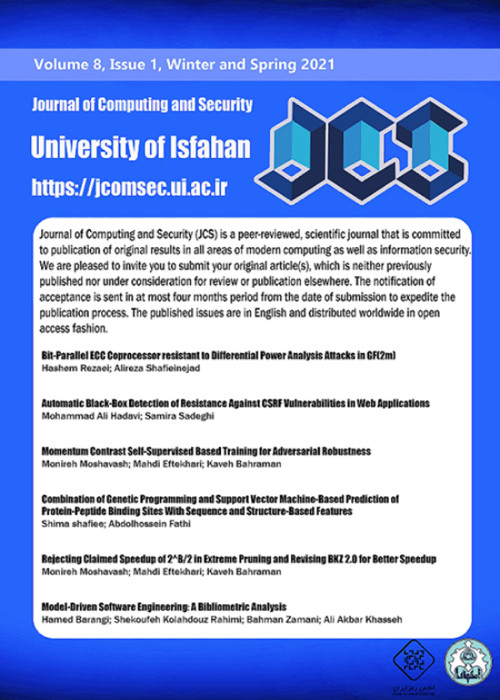فهرست مطالب

Journal of Computing and Security
Volume:2 Issue: 3, Summer 2015
- تاریخ انتشار: 1394/04/10
- تعداد عناوین: 6
-
-
Primitives Based on Jumping LFSRs with Determined PeriodPages 175-184Linear feedback shift registers (LFSRs) are used in many stream ciphers because of their maximal period and good statistical properties. Due to the linearity of the LFSR, its output cannot be directly used as the keystream. Different methods have been proposed to utilize LFSRs in construction of stream ciphers. Jumping is one of these methods which is used in some stream ciphers like Mickey and Pomaranch but the period for this method cannot be generally determined. In this paper, using the jumping LFSRs, some new primitives are proposed. According to the properties of these new primitives, a lower bound for their period can be computed. In some of the proposed primitives, this lower bound can be determined without the knowledge of the jump index. These primitives are applicable when the calculation of the jump index is infeasible. The proposed primitives can be used as building blocks to design the software oriented and the hardware oriented stream ciphers.Keywords: Stream Ciphers, LFSR, Jump Index, Period
-
Pages 185-194The rapid growth of information in IT context causes the IT companies outsource their information to data centers out of them. Since data security and privacy are among the main issues of outsourcing, IT admins should use cryptographic techniques to address these problems. Searchable encryption plays an important role in the context of outsourcing a companys information. In this paper we propose a secure communication scheme for cloud storage. We use a built-in mechanism to check the message integrity without using message digest, this will decrease the overhead of network traffic significantly. At first, we describe an attack to the SPKS (state of the art searchable cryptographic schemes for cloud storage networks) and show that the lack of client signature in SPKS helps intruders to forge the encrypted data. Then we propose a modified version of this scheme and prove its security against the forgery attack.Keywords: Searchable Encryption, Secure Cloud Storage, Asymmetric Encryption
-
Pages 195-207Fuzzy Inference systems have been successfully applied for different pattern recognition problems. However, in some real-world applications such as facial expression recognition, the uncertainties related to the feature space may be so high that it is hard to model the feature space by fuzzy membership functions. On the other hand, it is believed that type-2 fuzzy sets have high potentials of uncertainty management in the space of features. However, adjusting the parameters of Type 2 membership functions is a difficult task. In this paper, we analyze the effect of incorporating type-2 fuzzy system into facial expression recognition problem. In this regard, two adaptive type-2 fuzzy models are proposed. The first model employs interval type-2 Mamdani fuzzy system for constructing fuzzy face space and uses Genetic Algorithm for optimizing the membership functions parameters. The second model is an interval type-2 Neuro-Fuzzy system which contains interval type-2 fuzzy sets as membership functions. In this case, the gradient descent algorithm is utilized for tuning the parameters of this system. Numerical results demonstrate the superiority of type-2 fuzzy systems with respect to the corresponding type 1 systems and show that the proposed systems can better cope with the uncertainties in facial expression recognition.Keywords: Fuzzy Inference System, Interval Type, 2 Fuzzy Sets, Neuro, Fuzzy, Facial Expression Recognition
-
Pages 209-222An adaptive process consists of dynamic elements, and management rules which govern their run-time behaviors. The WS-CDL describes collaborative business processes between service consumers and providers. Adapting the processes to runtime changes becomes a demanding challenge, because the WS-CDL has static technology-dependent structure, and does not support the separation of concerns. Here, we propose a model-driven approach to transform WS-CDL into UML state machine (behavioral and protocol models), and subsequently into implementation code. Besides separating the business logic from the implementation, the state machine has a dynamic structure which is verifiable and adaptable. As a result, we can easily modify the process flow or change the management rules at run-time, and reflect their effects on the running process instances. We present an itinerary purchase case study for prototyping the transformation rules.Keywords: Service Choreography, Model, Driven Transformation, Adaptation, UML State Machine, Collaborative Business Process
-
Pages 223-231Recently, there has been an increasing need for storage spaces in the cloud centers. Efficient techniques for storing files can slow down this trend. In this paper, we investigate on the problem of storing replicated text files that have been changed by different users, individually. Each user could annotate their document by providing shapes and artworks, each of which may include text. The proposed scheme is based on storing the changes made by each user in a separate file for that user. Since the changes are applied to a minor part regarding the whole document text, storing them instead of the whole document could decreases the whole needed volume, significantly. Experimental results demonstrate the efficiency of the proposed scheme in terms of reducing the utilized storage space. Particularly, the proposed scheme is more efficient when the number of users or file size increases.Keywords: Cloud Computing, Big Data, Storage Service
-
New Functions for Mass Calculation in Gravitational Search AlgorithmPages 233-246Nowadays, optimization problems are large-scale and complicated, so heuristic optimization algorithms have become common for solving them. Gravitational Search Algorithm (GSA) is one of the heuristic algorithms for solving optimization problems inspired by Newton's lows of gravity and motion. Definition and calculation of masses in GSA have an impact on the performance of the algorithm. Defining appropriate functions for mass calculation improves the exploitation and exploration power of the algorithm and prevents the algorithm from getting trapped in local optima. In this paper, Sigma scaling and Boltzmann selection functions are examined for mass calculation in GSA. The proposed functions are evaluated on some standard test functions including unimodal functions and multimodal functions. The obtained results are compared with the standard GSA, genetic algorithm, particle swarm optimization algorithm, gravitational particle swarm algorithm and clustered-GSA. Experimental results show that the proposed method outperforms the state-of-the-art optimization algorithms, despite the simplicity of implementation.Keywords: Gravitational Search Algorithm, Heuristic Search Algorithm, Scaling Functions, Exploration, Exploitation, Mass Calculation


